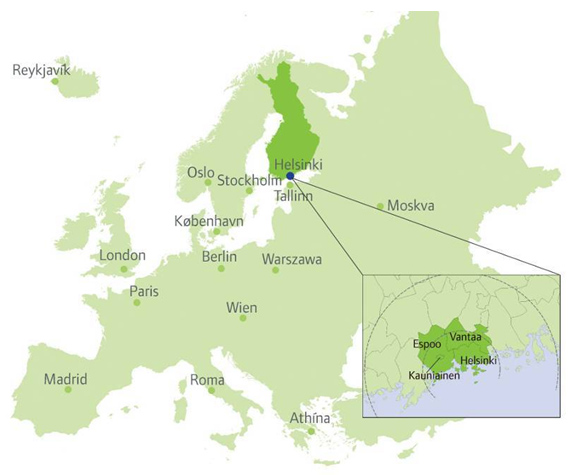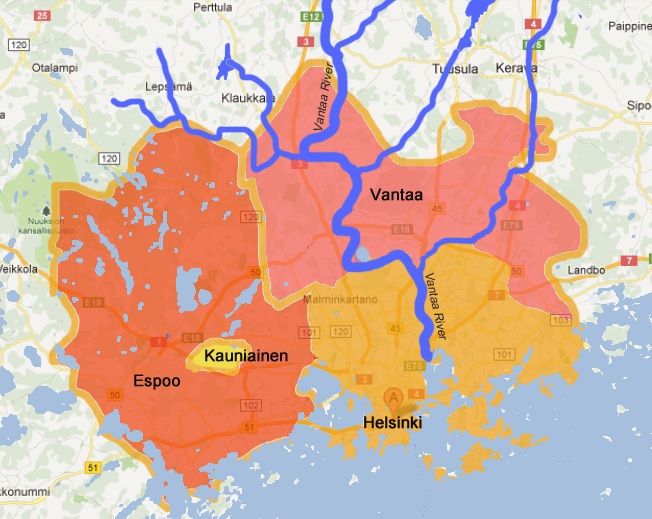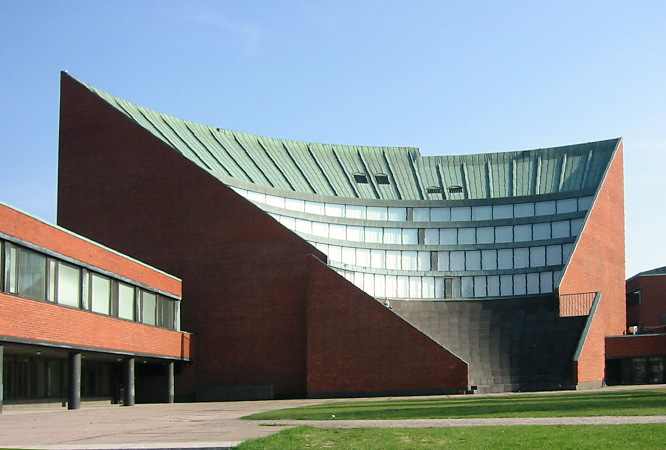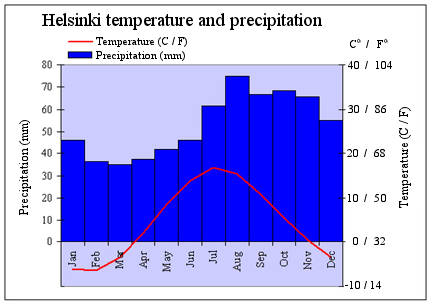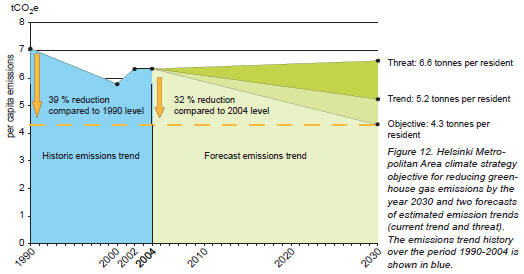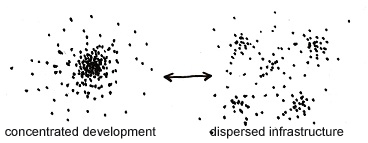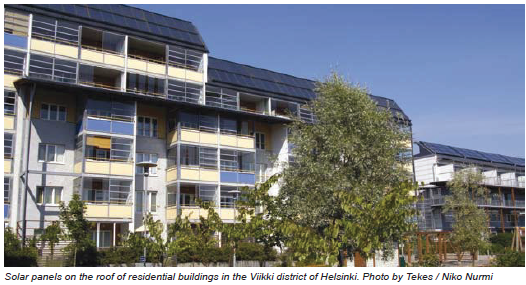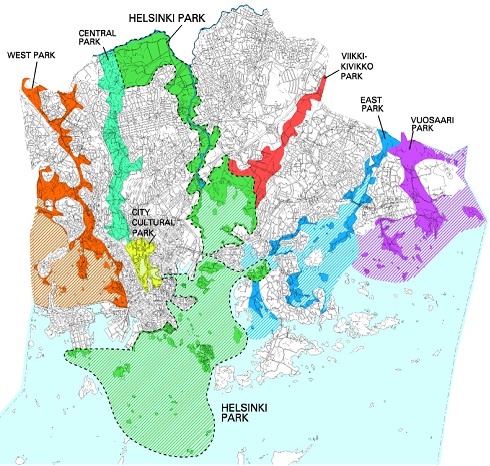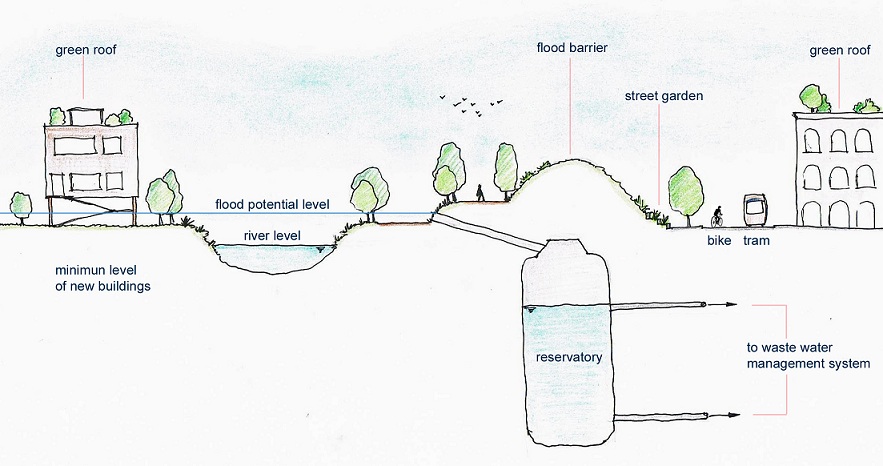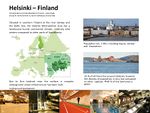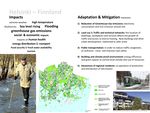Group N - Collaborative Climate Adaption Project
| Area | Helsinki Metropolitan Area | |
| Place | Helsinki | |
| Country | Finland | |
| Topic | See level rise, GHGs Emissions | |
| Author(s) | Andreia Oshiro, Carolina Esteves, Diana Cota | |

| ||
|
| ||
Rationale: Why have you selected this case study area?
- Finland is a pioneer in implementation of climate adaptation policies (since 2005). We believe that the study of Helsinki and metropolitan area can bring us valuable examples of how to create and support effective strategies.
- There are already some adaptation actions happening on local level and that could be a good example to follow and help other cities in similar situation.
Authors' perspectives
- Sustainable Landscape Planning should provide an interdisciplinary approach to protection, conservation and management of urban and rural landscapes, considering environmental, social and economic factors.
- There are many places and people who will face serious problems related to adaptation capacity to Climate Change. Most of them in developing countries have no or few conditions to invest in research and adaptive actions. Anlysis of successful cases can help us to elaborate more effective projects and strategies, as the impacts of Climate Change will be felt differently according to each case.
Landscape and/or urban context
- Helsinki – the capital of Finland - is situated at the mouth of the river Vantaa, in southern Finland, on the shore of the Gulf of Finland, an arm of the Baltic Sea. The city is spread across a number of bays and peninsulas and over about 315 islands.
- The metropolitan area involves also the cities, Espoo, Vantaa and Kauniainen, covering around 745 sq. km, with a total population of approximately one million. Only in Helsinki live 602,200 people, making it by far the most populous city in Finland. Therefore it has a density of 2,800 inhabitants per sq.km, which is relatively low in comparison with other European capitals (e.g. London: 5,206/sq.km; Stockholm: 4,600/sq.km; Brussels: 7,025/sq.km).
- Economy in this area is dominated by the services sector, with high concentration of jobs in information technology and the public sector.
- Green areas in Helsinki cover around 40% of the land. 20% of the surface is reserved for residential buildings, other buildings account for 13%, and around one fifth is for traffic.
- Helsinki is a leader in energy efficiency and ranks in 7th place in the European Green City Index.[3]
However, because of its high carbon dioxide (CO2) emissions and energy consumption, ranks in 11th among the 30 studied cities with a rate of 6 tons CO2/person, above the average 5tons. This is a result of the high need for heating buildings and rising energy consumption.
- The diverse public transport system consists of trams, commuter rail, the subway, bus and ferry lines. Its network is the shortest in Europe. However, the city ranks first with regard to the length of its cycling network, and is a leader in green transport promotion.
- Infrastructure: Since the 1960s, Helsinki has benefited from underground construction. The region is well suited to rock construction because its bedrock is hard and near the surface. In a dense urban structure, many functions are placed underground (industry parks, traffic system, sevices networks, recreation facilities, etc), near existent infrastructure.
Cultural/social/political context
Cultural context
Helsinki has extensive cultural offerings and quality of life of residents. Culture plays an important role in the City’s strategy, policies and decision making. Activities in Theater, Cinema, Music, Dancing, Museums, Art education, etc., are supported by Cultural Office in cooperation with other organizers. In 2012 Helsinki was designated World Design Capital by the International Council of Societies of Industrial Design (Icsid). Its Architecture is a comprise many styles, from classicism to art nouveau. Recently has been shaped by functionalism.
Helsinki University of Technology, auditorium of the main building. Espoo, Finland. Architect Alvar Aalto. [5]
Social context
According to many international studies, Helsinki is one of the cleanest cities in Europe. It is high rated in health and sanitation with some of the best drinking water in the world. General Education and Early Childhood care are promoted for Helsinki’s residents, as well as Higher Education and Research institutions. Helsinki is a fast growing metropolitan area and its foreign-born population is growing rapidly. Housing construction and development of new areas for housing are main priorities. The city aims at 5,000 new housing units per year, and offers many alternatives of housing to suit different lifestyles and life situations. Employment in the service sector is higher than in the whole country. Information technology, logistics, business services, high-tech industries as well as education and research are major employers in the region.
Political context
Helsinki, like all other Finnish municipalities, has a City Council. There are 3 large parties in the council of Helsinki. The National Coalition Party with 23 members, the Social Democrats with 15 members and the Green League with 19 members. The National Coalition Party has been the strongest party in the recent years. The relevant City Department is responsible for preparing a proposal on the motion and, when complete, the proposal is submitted to the relevant committee or board for decision making. The execution of a decision is handled by the proper department or City Group company according to each matter. Helsinki citizens are encouraged to participate and influence the decision makers of the city.
Local Climate
- The whole Helsinki area has a semiboreal humid continental climate with both continental and oceanic characters. Although the far northern location might indicate some very low temperatures, because of Baltic Sea and the Gulf Stream, these are pretty high, with the average in January and February around -5 °C.
- Extreme temperatures – minus 20 °C – occur rather rare, a week or two in year, mostly in the coldest month of the year February, with an average temperature of -6,6 °C.
- The hottest month is July, with an average temperature of 17,2 °C, when also temperatures over 30 °C might be possible.
- Average temperature around the whole year is 4,8 °C and the yearly amount of precipitation is about 689 mm (the most rainy month is January, about 73 mm and the driest March – 36 mm).
- The first snow falls in the middle of November, but a persistent layer of snow is only from December until march available.
- Because of the geographical position, days last less than six hours around the winter solstice with really low sun rays, and the very cloudy weather at this time of year accentuates the darkness. Conversely, Helsinki enjoys long days in summer, close to nineteen hours around the summer solstice.
Analysis of vulnerability
- Extreme weather & Temperature increase: during the 21st century the average temperature in Finland is expected to rise 3.2-6.4 degrees. The decrease of ice and snow cover will impact certain ecosystems. The air quality will decrease as a result of higher temperatures. Ultraviolet radiation will be more intensive, which could affect health and comfort of people. However, climate predictions do not give clear signal of lengthening of the dry periods in summer.
- Sea level rising: Exact regional projections are not conceivable, that give rise to the large uncertainties. Current estimates vary from 10 cm to 2 m by the end of the century. There will be impacts in coastal areas, including possible displacement of communities, social infra-structure, biodiversity and alterations to landform configurations.
- Flooding & - Storm water management: In Helsinki and metropolitan areas live approximately 1 million people that could be susceptible to exceptional seasonal flooding and need for evacuation. Road maintenance will also be affected by increasing rainfall.
- Energy distribution and maintenance of services and social networks: the citizens are very dependent of electricity because of the city’s cold climate and the high standard of living.
- Elderly can be especially vulnerable to certain weather events such as high temperatures, freezing on pavements, or storm-related damage that cuts off access to essential services. Other factors include living alone, chronic or severe illness, dependency on medications and social exclusion.
- Food security & Fresh water availability: Transport, storage, distribution and access to healthy food and provision of fresh water can be affected.
Illustration: Map/diagram/sketches/photos/background notes
Proposals for Climate Change Adaption
- Reduction of Greenhouse Gas Emissions: Electricity consumption should sink and CO2 emission should be reduced from 7.0 (rate in 1990) to 4.3 tonnes per resident by the end of 2030.
- Strategic planning of Land use: The location of dwellings, workplaces and services affects the growth of traffic and access to district heating in Helsinki, what influences greenhouse gas emissions.
- Energy efficiency: Buildings buitl with efficient insulation system and eco-friendly materials means lower energy consumption. Regulations and Tax benefits for such constructions help to sustain this measure.
- Sea levels rise and flooding: New buildings and other urban development should be redirected to safer areas and follow the recommended lowest base floor of new houses. Dikes, dams, sluices and locks could help to control flooding water.
(According to Helsinki Metropolitan Area climate strategy for 2030)
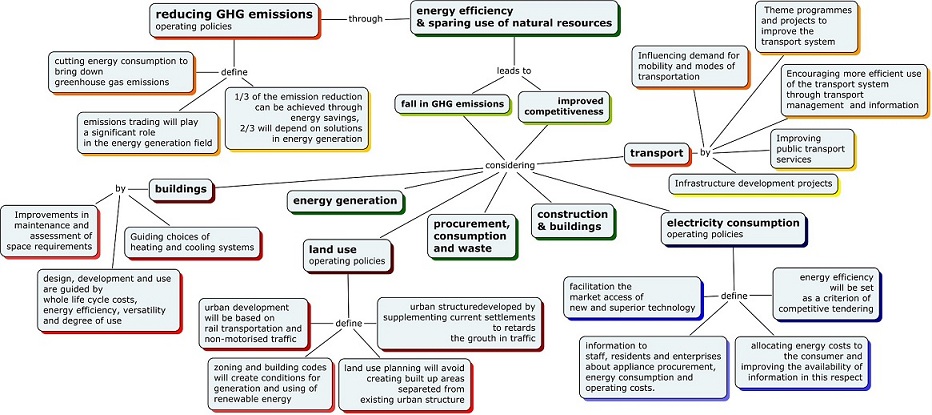
Current Projects:
- The BaltCICA Project is designed to focus on the most imminent problems that climate change is likely to cause in the Baltic Sea Region. The concentration of large parts of the population and many larger cities in coastal areas make the region especially sensitive to climate change.[9]
- Julia 2030 - Helsinki Region Environmental Services Authority (HSY)
The Julia 2030 project involves HSY, six municipalities of the Helsinki region, and the Finnish Environment Institute. The project aims to demonstrate how public sector services can reduce greenhouse gas emissions by improving the use of premises and energy efficiency in procurement, and also reducing the region's carbon emissions resulting from waste disposal. [10]
- Helsinki Metropolitan Area Climate Change Adaptation Strategy. The cities of the Helsinki Metropolitan Area Helsinki, Espoo, Vantaa and Kauniainen, HSY and other regional actors have prepared a joint regional strategy for adapting to climate change. The preparation work started in 2009 and was co-ordinated by HSY. [11]
Proposals for Climate Change Mitigation
Reducing greenhouse gas emissions in order to reduce global warming:
43 % of emissions in the Helsinki Metropolitan Area are due to heating buildings.
Electricity consumption causes 28 % and transport almost 20% of emissions.
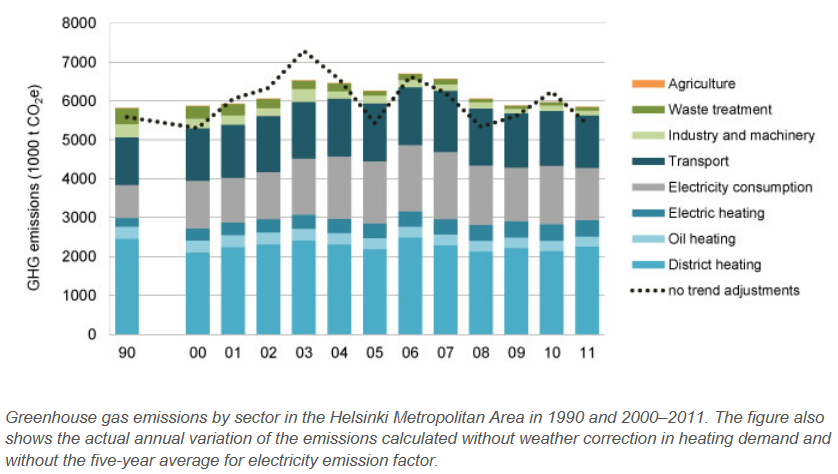 [12]
[12]
- Promote district heating: Emissions of electrically heated buildings and of buildings with separate individual heating systems are clearly higher than those of buildings that use district heating.
- Awareness of regional residents: Improve the awareness about the importance of reducing electricity consumption. Monitoring of consumption must be improved so that users of electric power pay according to their actual consumption.
- Promote Public Transport instead of private motoring: Besides significant GHG emissions, increased traffic has other consequences such as traffic congestion, affected air quality, increased noise levels and deteriorating road safety. Low ticket prices, rapid transport connections, frequent services and high quality standards are the most important factors for the competitiveness.
- Sustainable food supply: Is important to seek conditions such as self-sufficient production or alternatives like "Food Hubs", providing access to regional products.[13]
- Drainage: Water permeable asphalt in combination with efficient canalization and drainage system would help to accelerate water efflux. Those measures would help to cope in case of floods and increase road safety in strong rainfalls conditions.
- Alternative energy sources: Production of sustainable energy such as wind and wave power could be considered.
- Expand green spaces in urban area
Scenarios
Visions for Helsinki in 2060
- Lowest Carbon emission level & Highest alternative energy production rate
- Efficient use of Land with concentrated density areas, high developed underground infrastructure and more green spaces on the surface
- Intensive use of public transport systems and high bicycle traffic
- Waste is totally re-utilized to produce energy and recycled products
- Waste water and rain water are collected and utilized to all non-drinking uses in the city
- Helsinki has improved its food supply by cultivating on street gardens, green roofs and providing access to regional products
Propose for adaptation to Climate Change in Helsinki. Sketch by Andreia Oshiro.
What can be generalized from this case study?
- theoretical insights
Information and awareness of municipalities and decision makers, enterprises and communities are essential to achieve adequate policy definition, acceptance of adaptation and mitigation measures and general involvement.
Legislation changes and financial incentives are important to support adaptation strategies.
- generated questions
The information provided by researches, assessment and monitoring projects are very important to guide adaptation measures and strategies. However, under a global perspective, the implementation of such measures seems to be carried out without a proper urgency and comprisement. How to accelerate and drive the effectiveness of these actions?
- Short statement + background notes
Measures to Reduce GHG emissions in Helsinki Metropolitan Area has been implemented in public buildings as an example to be followed by private sector.
Besides the economic growth until 2008, emissions in this area began falling in 2007 influenced by lower emissions from district heating.
A compact urban structure creates opportunities for more efficient energy generation and distribution. The underground urban development provide a substantial advantage in sustainability and competitiveness.
Presentation Slides
References
http://www.oecd.org/environment/climatechange/36736773.pdf
http://www.naturvardsverket.se/upload/10_Forskning/poster-caravan.pdf
http://www.baltcica.org/casestudies/helsinki.html
http://www.oceansatlas.org/servlet/CDSServlet?status=ND0xODc3JjY9ZW4mMzM9KiYzNz1rb3M~
Landscape Architecture and the challenge of Climate Change http://www.landscapeinstitute.org/
http://blogs.usda.gov/2010/12/14/getting-to-scale-with-regional-food-hubs/
Helsinki Sanomat Internationl Edition – Metro https://www.hs.fi/english/article/Dozens+of+areas+at+risk+of+flooding+found+in+Helsinki/1135259632624
http://www.flickr.com/photos/sohvimus/5401593650/
http://www.siemens.com/entry/cc/features/urbanization_development/all/en/pdf/report_en.pdf]
http://en.uuttahelsinkia.fi/sections/5/environment/32/eco-efficient-land-use-and-construction
http://www.kirjavasatama.fi/pdf/southharbour_greenareassystem_helsinki.pdf
http://www.lewism.org/2009/10/09/subterranea-helsinki/
http://www.greennetfinland.fi/en/images/9/9b/Waste_burning_19012010.pdf
Helsinki underground master plan(video) http://edition.cnn.com/video/?/video/world/2011/02/14/qmb.fc.helsinki.underground.cnn
Image Gallery
<gallery caption=" " widths="150px" heights="150px" perrow="5"> Image:Vaanta.jpg|Vantaa River [18] Image:rivers helsinki.jpg|Vantaa River Basin[19] Image:Food for tomorrow.png|Proposal for Finland’s National Food Strategy [20] Image:Helsinki residential area.png|Eco-villas [21] Image:Itäkeskus underground swimming centre.jpg|Itäkeskus underground swimming centre [22]
About categories: You can add more categories with this tag: "", add your categories
